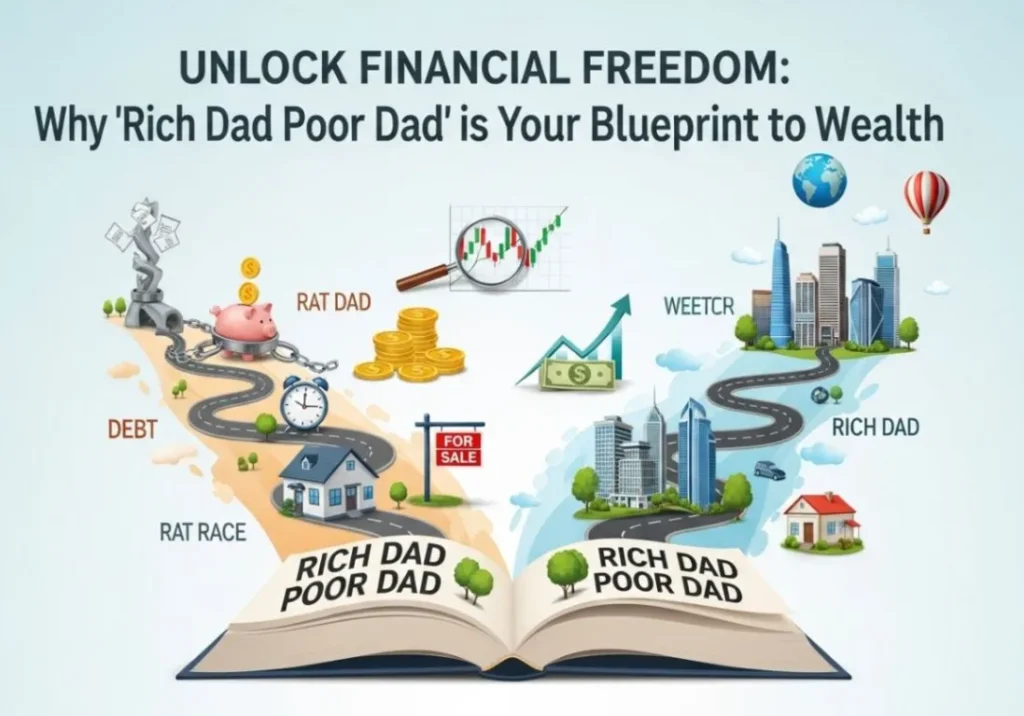Unlock Financial Freedom: Why “Rich Dad Poor Dad” is Your Blueprint to Wealth

Introduction: Escaping the Rat Race
Do you feel stuck on a financial treadmill? You work hard, get a raise, but your expenses always seem to catch up, leaving you with little progress. This frustrating cycle has a name: The Rat Race.
In 1997, a book emerged that didn’t just name the problem; it offered a clear blueprint to escape it. That book was “Rich Dad Poor Dad” by Robert T. Kiyosaki.
This isn’t a complex guide to stock picking. It’s about mindset. It’s a simple, powerful parable about two fathers and their profoundly different beliefs about money. More than two decades later, its lessons are more relevant than ever.
This guide will dissect Kiyosaki’s masterpiece, exploring its core lessons, the powerful CASHFLOW Quadrant, addressing controversies, and providing a concrete, actionable roadmap to apply its principles. Get ready to challenge everything you thought you knew about money.
The Core Parable: Meet Rich Dad and Poor Dad
The foundation of the book rests on Kiyosaki’s story of two father figures, representing two opposing financial philosophies.
The Two Financial Philosophies
- “Poor Dad” (The Employee Mindset): Kiyosaki’s highly educated biological father. His core belief was security through employment. He advised, “Go to school, get a good job, play it safe.” His financial strategy was defensive, focused on earning a paycheck and avoiding risk.
- “Rich Dad” (The Entrepreneur Mindset): His best friend’s father, a school dropout who became a millionaire. His core belief was freedom through assets. He advised, “Learn how money works so you can make it work for you.” His financial strategy was offensive, focused on creating wealth and managing risk.
This fundamental clash of mindsets—Scarcity vs. Abundance, Fear vs. Opportunity—is the engine that drives every lesson in the book.
The 6 Core Lessons of “Rich Dad Poor Dad”
Lesson 1: The Rich Don’t Work for Money
This is not about laziness; it’s about wealth creation. The “Rat Race” is working for a paycheck, getting a raise, increasing your spending, and thus remaining trapped. You are trading your time for money that is consumed by taxes and liabilities.
The rich don’t work for money because they’ve built or acquired systems (assets) that generate income for them, independent of their time.
The goal isn’t a bigger bucket (higher salary); it’s building a pipeline (an asset portfolio) so your money works for you.
Lesson 2: Why Teach Financial Literacy? (Assets vs. Liabilities)
“It’s not how much money you make, but how much money you keep.” This is the essence of financial literacy. Rich Dad’s definitions are simple and effective:
- An Asset: Something that puts money IN your pocket.
- A Liability: Something that takes money OUT of your pocket.

The poor and middle class often mistake liabilities (like their mortgaged primary home or car loan) for assets. The rich focus on building their asset column first—with real estate, stocks, and businesses—which then generates passive income to pay for luxuries. This creates a virtuous cycle of increasing wealth.
Lesson 3: Mind Your Own Business
This lesson emphasizes focus. Rich Dad explained that your profession is what pays the bills, but your business is your asset column. “Minding your own business” means actively building and nurturing your asset column on the side, even while keeping your day job.
Instead of buying a new TV, buy a share of a dividend-paying ETF. Instead of upgrading your car, save for a down payment on a rental property. Use your income to buy assets.
Lesson 4: The History of Taxes and the Power of Corporations
The rich play the tax game differently by using corporate structures (like an LLC or S-Corp). The middle-class formula is: Earn → Pay Taxes → Spend. The rich formula is: Earn → Spend/Reinvest → Pay Taxes on what’s left. A corporation allows legitimate business expenses to be paid before taxes are calculated on the remaining profit, acting as a financial shield.
Lesson 5: The Rich Invent Money
This is about creating wealth through financial intelligence, not just hard work. Your mind is your most powerful asset. True wealth is created by those who can see opportunities others miss, structure creative deals, and solve financial problems. “Inventing money” means creating deals where none existed, turning knowledge into cash flow.
Lesson 6: Work to Learn, Don’t Work for Money
This brings the lessons full circle. Your career path should be guided by learning, not just earning. Take jobs that teach you critical skills like sales, marketing, communication, and leadership, even if they pay less. Many talented people struggle financially because they focus only on their craft but lack the skills to market and sell.
The CASHFLOW Quadrant: Your Map to Financial Freedom
Kiyosaki categorizes everyone based on how they earn income:
The Four Quadrants
- E (Employee): You have a job. Core value: Security.
- S (Self-Employed/Specialist): You own a job. Core value: Independence.
- B (Business Owner): You own a system and people work for you. Core value: Wealth Creation.
- I (Investor): Your money works for you. Core value: Financial Freedom.
The left side (E and S) is where people work for money. The right side (B and I) is where money works for you. The path to freedom is to move from the left side to the right side, using your income as an E to become an I.
10 Actionable Steps to Apply “Rich Dad Poor Dad”
- Define Your “Why”: A deep emotional reason fuels perseverance.
- Conduct a Financial Audit: List all income and expenses.
- Identify Your Assets and Liabilities: Use Rich Dad’s definitions to see your true cash flow.
- Pay Yourself First (for Assets): Automate investments before paying bills.
- Start Your Financial Education: Your mind is your greatest asset. Read, listen, learn.
- Find a Mentor or a Community: Surround yourself with people on the same path.
- Master One Investment Strategy: Go deep in one area (e.g., real estate, index funds).
- Look for Problems to Solve: Shift from “I can’t afford it” to “How can I afford it?”
- Make Offers: Be willing to act. The fear of rejection is paralyzing.
- Take Calculated Risks: Start small. Your first investments are for education.
Is “Rich Dad Poor Dad” Perfect? Addressing the Criticisms
No discussion is complete without a balanced look. Critics point to the ambiguity of whether “Rich Dad” was real, the book’s oversimplification, its risky advice on using debt, and the ethics of its tax strategies. It’s crucial to see the book as a philosophical starting point, not a technical manual. It’s designed to change your mindset, after which you must seek detailed, practical knowledge elsewhere.
Why “Rich Dad Poor Dad” Still Resonates Decades Later
Despite criticisms, the book remains a bestseller. Why? In a world of gig work and side hustles, its message of building assets and multiple income streams is more relevant than ever. Ultimately, its enduring power lies in its psychological impact. It grants you permission to think differently from the crowd and transforms money from a source of fear into a game to be learned and won.
This mindset shift is the first, and most important, step on the path to financial freedom.
Your Journey Starts Now: The Final Takeaway
“Rich Dad Poor Dad” is not a magic wand. Reading it won’t instantly make you rich. But it will crack open the door to a new way of thinking. It will plant a seed of possibility in your mind—the possibility that you don’t have to be trapped in the Rat Race forever.
The journey from the left side of the CASHFLOW Quadrant to the right side isn’t easy. It demands education, courage, and persistence. But it begins with a single decision: to take control of your financial future. Stop working for money. Start building your asset column. Mind your own business. And most importantly, never stop learning.





Your Turn!
What was the most impactful lesson you learned from “Rich Dad Poor Dad”? Share your thoughts and your first action step in the comments below!